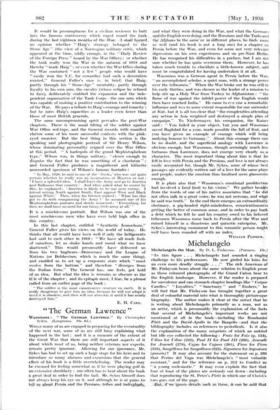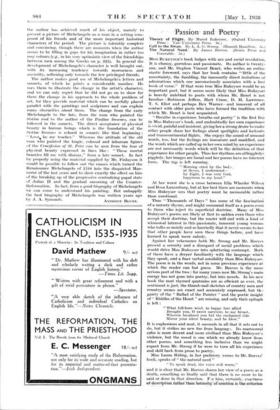Michelangelo
Michelangelo the Man. By D. L. Finlayson. (Putnam. 15s.) "IN this figure . . . Michelangelo had sounded a ringing challenge to- his 'predecessors. He now girded his loins for an even more deadly struggle . ." - The rich American of Mr. Finlayson bears about the same relation to English prose as those coloured photographs of the Grand Callon bear 'to the English landscape. However, if the reader is prepared for succulence and can stomach chapter headings like " Corpse Candles," " Loyalties," " Sanctuary " and " Embers," he will find that Mr. Finlayson has brought together a great deal of colourful material into what is thoroughly picturesque biography. The author makes it clear at the outset that he is writing about Michelangelo primarily as a man, not as an artist, which is presumably the explanation of the facts that several of Michelangelo's important works are not mentioned at all in the book—including the Rondanini Pieta and the David-Apollo in the Bargello—and that the bibliography includes no references to periodicals. Is it also the explanation of the many misprints of which an unkind but idle eye collected the following Proix for Foix (p. 184), Udino for Udine (222), Paul II for Paul III (260), Aram& for A rocoeli (276), Cajao for Cajano (281), Piero for Pirro (316), Sangelksea for Sangallesca (323), Signalura for Segnatuta (paSsiin)? It may also aceolint for the statement on p. 293 that Perin° del .Vega was Michelangelo's. " most valuable assistant," and for the reference on p. 312 to Condivi as " a young ecclesiastic." It may even explain the fact that four at least of the plates are seriously cut down—including that reproducing the St. Peter's Pieta in which one of Christ's toes gqes out of the page.
.1...Btit,Af'we' ignore-details- ktich aiN -these, it- can be said that the author has achieved much of his object, namely to present a picture of Michelangelo as a man in a setting com- posed of his friends and of the more important historical characters of the period. The picture is tolerably complete and convincing, though there are moments when the author seems to be filling in gaps for his imagination in rather too rosy colours (e.g., in his very optimistic view of the friendships between men among the Greeks on p. 225). In general the development of Michelangelo's character is well brought out, with its increasing tendency towards moroseness and austerity, softening only towards the few privileged friends.
The author makes good use of Michelangelo's letters and sonnets, of which he prints a considerable number. He uses them to illustrate the change in the artist's character, and we can only regret that he did not go on to show for them the change in his approach to the whole problem of art, for they provide material which can be usefully placed parallel with the paintings and sculptures. and can explain many obscurities about them. The change from the early Michelangelo to the late, from the man who painted the Sistine roof to the author of the Pauline frescoes, can be followed in the, sonnets. The direct acceptance of physical beauty in human beings which is the foundation of the Sistine frescoes is echoed in sonnets like that beginning : " Loves be my teacher." Whereas the attitude of the old moan who painted the tragic, colossal and inhuman figures of the Crucifixion of St. Peter can be seen from the fear of physical beauty expressed in lines like : " These mortal beauties fill me with dismay," from a late sonnet. In fact by. properly using the material supplied by Mr. Finlayson it would be possible to follow out the causes which turned the Renaissance Michelangelo of 1510 into the disquieted Man- nerist of the last years and to show exactly the effect on him of the breaking up of the progressive centralising papal state if Julius II and the gradual oncoming of the Counter- Reformation. In fact, from a good biography of Michelangelo we can come to understand his painting. But unhappily the best biography of Michelangelo was written years ago















































 Previous page
Previous page